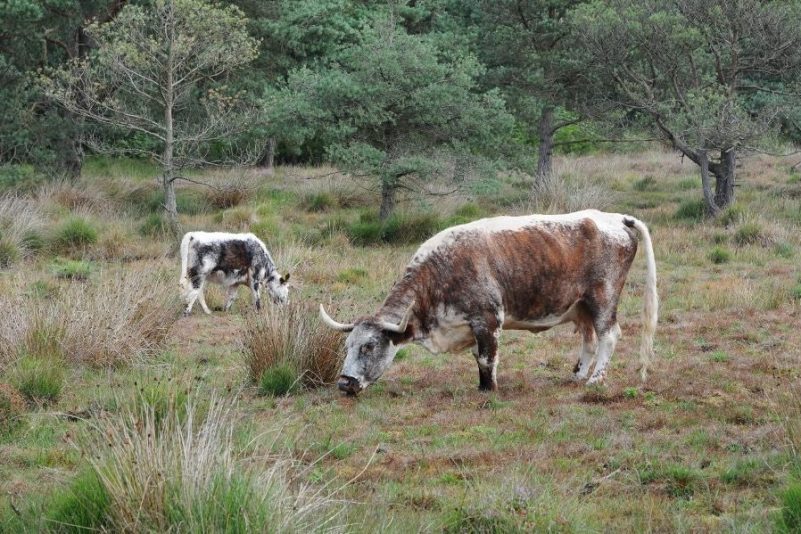Greenhouse Gas Emissions & Conservation Grazing: What We Don’t Know

Livestock production systems form a continuum from very intensive systems, requiring substantial inputs of high-quality feed and fertiliser, to much more extensive systems, with lower outputs and less reliance on non-renewable inputs. In the most extensive systems, livestock can play a valuable role in conservation as well as meat production, helping to maintain semi-natural, open habitats, through low intensity grazing. These habitats represent some of the most important priority habitats for biodiversity (Pykälä, 2000) and could also play a key role in climate change mitigation through carbon sequestration and storage in their soils and vegetation, whilst providing a source of high-quality meat protein.
Any potential carbon sequestration in the soils and vegetation of grazed habitats will be balanced against greenhouse gas emissions from the grazing livestock. Natural England have recently published a report (Manning et al., 2023) they commissioned from ADAS to review existing data and develop a calculator tool to predict net greenhouse gas emissions from semi-natural grazed habitats. The aim was to consider carbon storage/ emissions from a range of habitat types alongside emissions from livestock grazing them, to calculate the net greenhouse gas flux from extensively grazed sites, including those managed by Natural England. The tool could then be used to calculate carbon budgets for sites and help site managers understand how changes in management, e.g. changes in stock type, could influence greenhouse gas emissions.
The review of existing data identified significant knowledge gaps that severely limit our ability to predict net greenhouse gas emissions from semi-natural, grazed habitats. Data on habitat fluxes were found to be sparse, uncertain and highly variable and it was decided not to include these data in the calculator. A calculator was developed to try and predict livestock derived emissions from different species/ size categories of livestock. However, there was a lack of empirical data from appropriate semi-natural habitats, to feed into the calculator, instead standard equations published in the Intergovernmental Panel on Climate Change (IPCC) Guidelines for National Greenhouse Gas Inventories for Agriculture, Forestry and Other Land Use (IPCC, 2019) were used. A Limitation of applying these equations to conservation grazing scenarios is that they were developed using measurements made on much more intensive systems. Previous research has highlighted several variables that significantly impact on livestock derived emissions and differ substantially between more intensive and more extensive systems (Ramsay et al., 2023). These include, total feed intake, livestock activity level, livestock genetics, forage quality in the diet, presence of methane suppressing compounds in the diet and variations in rumen microbiome. Variations in these factors are either poorly captured or not captured at all within the standard IPCC equations used.
The (Tier2) IPCC equations, used in the calculator tool for cattle/ sheep emissions, allow you to include data on forage quality (digestibility and protein content), however a lack of site-specific data from semi-natural UK habitats meant standard ‘poor quality forage’ data were used, primarily based on forage digestibility/ protein content measured on extensive rangelands as grazed in the USA. Tier2 equations also attempt to account for livestock activity level, but again no context specific data were available and for all sites an activity level coefficient equivalent to ‘grazing hilly pastures’ for sheep and ‘grazing large areas’ for cattle was assumed. The (Tier1) IPCC equations used to predict emissions from horses/ponies did not account for diet variability or activity level at all. Potential variability in emissions due to other factors including, livestock genetics, presence of methane suppressing compounds in the diet and variations in rumen microbiome were not considered at all in the standard IPCC equations used.
The limitations around estimating habitat carbon sequestration identified through this project are being addressed in part by the Nature Returns project. This is a multi-million-pound Natural England led partnership project, which through collaboration between government and the private sector is exploring how to best use land across England to address climate change whilst producing food and promoting thriving nature, as well as how to mobilise the significant investment needed to meet net zero. Part of this work is funding nature-based solutions to climate change (NbS) on 5 pilot sites that represent a range of habitats and recording the net greenhouse gas flux. However, there are no plans within this to measure greenhouse gas emissions from livestock grazing semi-natural habitats. Addressing this significant knowledge gap could be vital in helping:
- Individual food producers and organisations looking to minimise their carbon footprint and develop local and national markets for more environmentally sustainable products.
- Those looking to sell or purchase carbon credits delivered through management of grazed semi-natural habitat.
- Policy makers looking to evaluate future land use scenarios and develop policies designed to deliver ambitious biodiversity, food production and greenhouse gas emissions targets.
Furthermore, undertaking research on more diverse systems will provide a greater understanding of the factors influencing greenhouse gas emissions from livestock, which could potentially be applied to reduce emissions from across the livestock production sector.
Through commissioning this piece of work on the impact of conservation grazing on greenhouse gas emissions, Natural England have identified a vital need for more research. We propose the collection of direct measurements of livestock derived greenhouse gas emissions from semi-natural grazed systems, alongside other data including on forage quality, and livestock activity level. This could include research on the extensive National Nature Reserve Network, managed by Natural England. We are keen to identify and work with partners to develop research projects in this area. The findings of our research and opportunities for collaboration to address evidence needs will be discussed further at a virtual webinar to be held on 20th June 2023, If you are interested in attending the webinar or discussing collaborations in this research area please contact Claire Horrocks at: [email protected]
References
IPCC (2019) Refinement to the 2006 IPCC Guidelines for National Greenhouse Gas Inventories. Volume 4 Agriculture, Forestry and Other Land Use. Switzerland: IPCC
Manning, F., et al. 2023. The Impact of Conservation Grazing on GHG emissions. NECR489. Natural England.
Pykälä, J., 2000. Mitigating human effects on European biodiversity through traditional animal husbandry. Conservation Biology,14(3), pp.705-71
Ramsay, J. et al. 2023. Reducing Greenhouse Gas emissions from conservation grazing: a literature review and exploration of options. Report for the Royal Society of Wildlife Trusts. Wild Business Ltd. London, UK.
The LUNZ Blog
The LUNZ Blog provides a forum for Hub members, partners and other stakeholders to share their own research and perspectives and reach a variety of new audiences using accessible language. This could feature a new piece of research or a response to media stories on land use and net zero. The views expressed in this Blog are solely of the author do not necessarily reflect those of the LUNZ Hub.
Subscribe to our Newsletter
A quarterly update of all LUNZ Hub activities, events and news stories.

